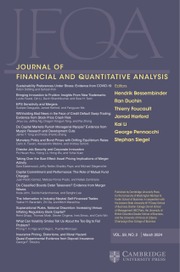Article contents
Convertible Debt Arbitrage Crashes Revisited
Published online by Cambridge University Press: 27 April 2023
Abstract
This article examines the severity of the 2008 arbitrage crash in the convertible bond market by estimating how expensive it would have been to liquidate portfolio securities immediately. We consider whether funds actually demanded immediate liquidity or were able to delay trades. Our results indicate that the cost of immediacy was high, but that convertible bond sellers could largely avoid selling at fire sale prices. These results can be explained by dealers recognizing when trades are liquidity-motivated rather than information-based and by a shift to riskless principal trading, allowing dealers to avoid taking bonds into inventory.
- Type
- Research Article
- Information
- Creative Commons
- This is an Open Access article, distributed under the terms of the Creative Commons Attribution licence (https://creativecommons.org/licenses/by/4.0), which permits unrestricted re-use, distribution and reproduction, provided the original article is properly cited.
- Copyright
- © The Author(s), 2023. Published by Cambridge University Press on behalf of the Michael G. Foster School of Business, University of Washington
Footnotes
The authors thank Hendrik Bessembinder (the editor), Jay Ritter, Christoph Schenzler, Norman Schürhoff (the referee), Li Ting Chiu, and seminar participants at Bocconi University, the Office of Financial Research, the University of Washington, and Erasmus University Rotterdam for helpful comments and discussion.
References
- 2
- Cited by


